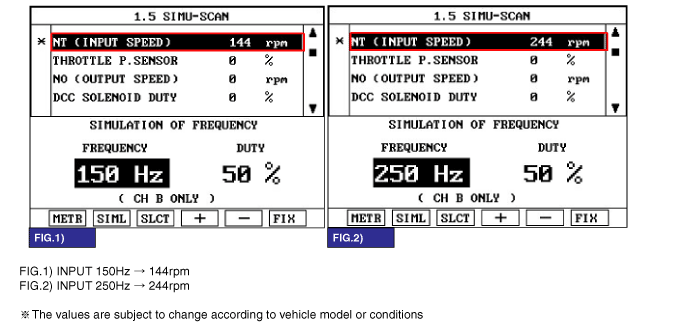Driving at speed of over 19 Mile/h(30 Km/h).
Specification : Increasing Gradually


The input(turbine) speed sensor outputs pulse-signals according to the revolutions of the input shaft of the transmission. The TCM determines the input shaft speed by counting the frequency of the pulses. This value is mainly used to control the optimum fluid pressure during shifting.
The TCM sets this code if an output pulse-signal is not detected, from the input speed sensor, when the vehicle is running faster than 30 km/h. The Fail-Safe function will be set by the TCM if this code is detected.
Item | Detecting Condition | Possible cause |
DTC Strategy | ● Speed rationality check | ● Signal circuit is open or short. ● Sensor power circuit is open ● Sensor ground circuit is open ● Faulty INPUT SPEED SENSOR ● Faulty PCM/TCM |
Enable Conditions | ● Vehicle speed is over 19 Mile/h(30 Km/h) and Ne≥1000rpm in D,3,2,L(A/T range switch) and SP(SPORTS MODE) ● 11V ≤ Battery Voltage ≤ 16V ● TM oil temperature ≥ -23°C(-9.4°F) | |
Threshold value | ● No signal | |
Diagnostic Time | ● More than 1sec | |
Fail Safe | ● Locked into 3rd or 2nd gear ● Manual shifting is possible(2nd → 3rd, 3rd → 2nd) |

Input shaft & Output shaft speed sensor
Type : Hall sensor
Current consumption : 22mA(MAX)
Sensor body and sensor connector have been unified as one.
Connect scan tool to data link connector(DLC).
Engine "ON".
Monitor the "INPUT SPEED SENSOR" parameter on the scantool.
Driving at speed of over 19 Mile/h(30 Km/h).
Specification : Increasing Gradually

Does "Input speed sensor" follow the reference data?

▶ Fault is intermittent caused by poor contact in the sensor's and/or TCM(PCM)'s connector or was repaired and TCM(PCM) memory was not cleared. Thoroughly check connectors for looseness, poor connection, bending, corrosion, contamination, deterioration or damage. Repair or replace as necessary and go to "Verification of Vehicle Repair" procedure.

▶ Go to "Terminal & connector inspection" procedure.
Many malfunctions in the electrical system may be caused from poor harness and terminal condition. These faults can be caused by interference from other electrical systems and mechanical or chemical damage.
Thoroughly check connectors for looseness, poor connection, bending, corrosion, contamination, deterioration, or damage.
Has a problem been found?

▶ Repair as necessary and go to "Verification of vehicle repair" procedure.

▶ Go to "Signal circuit inspection" procedure.
Ignition "ON" & Engine "OFF".
Disconnect the "INPUT SPEED SENSOR" connector.
Measure voltage between terminal "2" of the INPUT SPEED SENSOR harness connector and chassis ground.
Specification : approx. 5V

Is voltage within specification?

▶ Go to "Power supply circuit Inspection" procedure.

▶ Check for open or short in harness. Repair as necessary and Go to "Verification of Vehicle Repair" procedure.
▶ If signal circuit in harness is OK, Go to "Check PCM/TCM" of the "Component Inspection" procedure.
Ignition "ON" & Engine "OFF".
Disconnect the "INPUT SPEED SENSOR" connector.
Measure voltage between terminal "3" of the INPUT SPEED SENSOR harness connector and chassis ground.
Specification : approx. B+

Is voltage within specification ?

▶ Go to "Ground circuit inspection" procedure.

▶ Check for open in harness. Repair as necessary and Go to "Verification of Vehicle Repair" procedure.
Ignition "ON" & Engine "OFF".
Disconnect the "INPUT SPEED SENSOR" connector.
Measure resistance between terminal "1" of the INPUT SPEED SENSOR harness connector and chassis ground.
Specification : approx. 0 Ω

Is resistance within specification ?

▶ Go to "Component Inspection" procedure.

▶ Check for open in harness. Repair as necessary and Go to "Verification of Vehicle Repair" procedure.
▶ If ground circuit in harness is OK, Go to "Check PCM/TCM" of the "Component Inspection" procedure.
Check "INPUT SPEED SENSOR"
Ignition "OFF".
Disconnect the "INPUT SPEED SENSOR" connector.
Measure resistance between terminal "1","2" and "2","3" and "1","3" of the "INPUT SPEED SENSOR" connector.
Specification : Refer to "Reference data"

Is resistance within specifications?
Data | Reference Data | |
Current | 22 mA | |
Air Gap | Input sensor | 1.3 mm |
Output sensor | 0.85 mm | |
Resistance | Input sensor | Above 4 ㏁ |
Output sensor | Above 4 ㏁ | |
Voltage | High | 4.8 ~ 5.2V |
Low | Below 0.8V | |

▶ Go to "CHECK PCM/TCM" as below.

▶ Replace "INPUT SPEED SENSOR" as necessary and Go to "Verification of Vehicle Repair" procedure.
CHECK PCM/TCM
Ignition "ON" & Engine "OFF".
Connect "INPUT SPEED SENSOR" connector.
Install scantool and select a SIMU-SCAN.
Simulate frequency to INPUT SPEED SENSOR signal circuit.

Is "INPUT SPEED SENSOR" signal value changed according to simulation frequency?

▶ Thoroughly check connectors for looseness, poor connection, bending, corrosion, contamination, deterioration, or damage. Repair or replace as necessary and then go to "Verification of Vehicle Repair" procedure.

▶ Substitute with a known-good PCM/TCM and check for proper operation. If the problem is corrected, replace PCM/TCM as necessary and then go to "Verification of Vehicle Repair" procedure.
After a repair, it is essential to verify that the fault has been corrected.
Connect scan tool and select "Diagnostic Trouble Codes(DTCs)" mode.
Using a scan tool, Clear DTC.
Operate the vehicle within DTC Enable conditions in General information.
Are any DTCs present?

▶ Go to the applicable troubleshooting procedure.

▶ System performing to specification at this time.